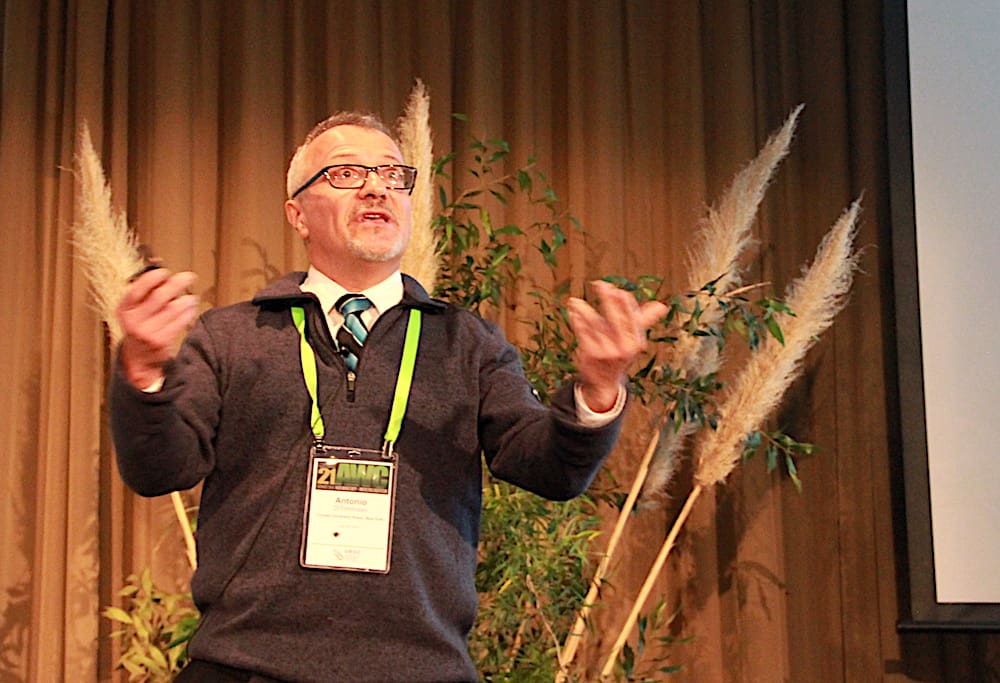
Keynote speaker Professor Antonio DiTommaso from Cornell University in New York discussed how changing climates are likely to impact future weed distribution.
IT’S highly likely Australian farmers, like their counterparts overseas, will be dealing with weed issues in future they’re not aware of yet.
A world leading authority on weed management says to manage this change Australian growers must arm themselves with as much information as possible about weeds, be hyper vigilant to ensure early identification, and act on any changes they see immediately.
Antonio DiTommaso, a professor of weed science at Cornell University in Ithaca, New York, told the 21st Australasian Weeds Conference in Sydney on Monday that warming temperatures will lead to weeds adapting and appearing in places they have never previously appeared.
In his home in the northern eastern United States, average winter temperatures have risen by 1 to 4 degrees Celsius since 1970. With the warmer temperatures have come changing plant behaviours, with lilacs now blooming four days earlier on average, grapes six days earlier and apples 8 days earlier.
Weeds are biological beings that are adapting to changing climatic conditions as well, he said.
The voracious vine Kudzu– known as the “weed that ate the south” in America – has never been a problem for farmers in the northern States in the past, but is nowmoving into the region as temperatures increase and surviving the northern winters.
‘Know your enemy’
 Professor DiTommaso’s message to Australian farmers is “know your enemy”.
Professor DiTommaso’s message to Australian farmers is “know your enemy”.
“My advice to Australian farmers is similar to what we’re experiencing in the US: it’s about information, information, information,” he told Grain Central.
“We can’t simply say, we’ve never had to worry about these species.
“It is education, listening to other folks, being aware globally of where these species are coming from that are likely to be here, what folks in those countries or in those regions are doing.
“What tools are out there, such as integrated pest management, and if we do have herbicides available, are they going to be efficacious under those conditions?
“Know your enemy, inside out, the biology and the ecology.”
Farmers must be better stewards of glyphosate
Glyphosate was a tremendously valuable product, he said. but it had been misused and overused.
Thirty-nine weed species have now evolved resistance to glyphosate, distributed across 37 countries and in 34 different crops.
In the United States 98pc of soybeans were roundup resistant, along with 95pc of corn and over 90pc of cotton.
Professor DiTommaso said industry needed to be better stewards of these valuable tools they have in their toolbox.
“I understand the economics, there is a reason we have a 98pc adoption rate of Glyphosate, but we have got be climate smart in agriculture,” he told Grain Central.
“There is now dicamba resistance. There is this kind of idea that we go from one to another without really looking at the cause.
“We need to be smart about this, the solutions are not easy but the information is there.
“The idea that industry will save us and magically come up with some silver bullet (i.e. new chemistry), that is just not going to happen.
“So it is about integration, rotating crops, being aware of species that you have never seen on your land before, and really jumping on it, don’t sit back.”
Professor DiTommaso said it was not all doom and gloom but continued dependency on one tactic was not a solution for the future.
“I think industry recognises that too, so that is why you have the WeedSmart program.
“Glyphosate is an important tool in the tool box, but it must not be the only tool.”
“Folks are so dependent on it my issue has been over reliance.
“We might drive this really valuable tool into the ground.
“That is what concerns me, we have got to do a better job and let our growers know, industry is not going to save us all the time.”

Re..” Warmer Temps will bring New Weed Threats”,has caught my attention as some news regarding Roundup has been offered lately that the product has lost a court case in the USA the use of the herbicide will be discontinued in the USA. We in Canada have recognized that global warming is taking place as many Provinces have begun to plant corn crops where increased heat units now permit it to grow. Trouble is most varieties of seed are GMO. Also corn needs more moisture than the usual crops that we have been utilizing for decades that are not GMO free. The market has changed and not much seems to be proffered to the anxious farmers from the Big Five Seed Companies to meet the food and feed crops required . There is one crop that has been rejected by the the Five for many years that can fill the bill . Helianthus Tuberosus , a member of the Sunflower Family, also known as Jerusalem Artichoke, a name that is not appropiate in Australia I have been told . Called Topinambur in France , Cicoka , in Slavic nations , China and Russia have names I can not pronounce. The crop is a perenial , discribed well in Feedipedia where it is compared to Alfalfa as a Feed Crop. Agriculture Canada recently added it to our Registered Feed List . The crop is not listed as one that falls under the authority of Bill C18, which denies the farmer use of the crop grown to replant the crop and purchase new seed for the following season. With JA the man who grows the crop owns it and his first income from it comes from seed sales. JA contains fructose sugar, which is 50 % sweeter than sucrose and diabetic friendly. I suggest Aus . gives up on GMO cane sugar and and high fertilizer bills and keeps the Reef healthy. Visit, http://www.novagreen.ca and see what is going on in Alberta Canada . I would be pleased to offer further info , like the crop can be grown in saline waters, and I understand that many bore wells there are not used … but could be. with this exciting crop. Regards . Larry Whetstone .